Genre: Sports Developer: Double Diamond Sports Publisher: Sega of America Released: 1994
On January 22, 1989 Joe Montana became an American hero. Montana was already considered one of the NFL’s elite quarterbacks after winning the Super Bowl with the 49ers in 1981 and 1984, but in Super Bowl XXIII on that January evening in ’89, he became something more. With the 49ers down 16-13 in the final three minutes, Montana led his team on an eleven-play, 92-yard drive for the winning touchdown in the final seconds of the game. Every kid in America with a football and a backyard wanted to be like Joe Montana after that amazing game. Later that year, Sega debuted its new Genesis home arcade system, and in 1990 it signed Montana to a five year, $1.7 million dollar contract to help prove that “Genesis Does What Nintendon’t.” Montana’s run on the Genesis helped Sega compete with EA’s Madden franchise through the years with Joe Montana Football in 1990, Joe Montana II: Sports Talk Football in 1991, NFL Sportstalk Football ’93 in 1992, and the impressive NFL ’94 in 1993. The competition between Sega, and EA pushed developers to improve their football franchise with each annual release, resulting in a fast evolution of the genre during the 16-bit era, and a strong reputation of quality football games for the Genesis. After a comeback in ’93 to the Kansas City Chiefs, Montana embarked on his final NFL season in 1994, and appeared in his final Sega Genesis football game, NFL ’95.
Even though NFL ’95 is usually overlooked as just another Genesis football game, many forget that it was a big step forward for the genre at the time of its release. Even though the “Un-bay-lievable” running commentary and customizable gameplay perspective of NFL ’94 was abandoned, NFL ’95 had features and depth that console football gamers had yet to see in the 16-bit era. NFL ’95 was one of the first console games that allowed players to create a profile, as well as the ability to modify team rosters with trades and free agent signings. You can also release players and modify each team’s depth chart. All of this freedom with the rosters gave the game a good bit of replay value, and add to that the ability to play through three different schedules in the regular season(1992, 1993, and 1994), and NFL ’95 had the potential to keep you busy for quite some time.
As welcomed as NFL ’95’s features were, it’s most innovative aspects were its graphics and gameplay. NFL ’95 was one of the first football games that took presentation seriously. All of the menus have a very colorful, modern feel to them, especially compared to other 16-bit football games. There are even actual player photos in the game of the more popular “franchise” players of the era, which was also a first for the time. Furthermore, it was one of the first football games with a modern 3D camera system. As the quarterback dropped back to pass, the camera would drop back, and pan down to allow you to see up to 65 yards down the field. Once the ball is caught, or handed off, the camera quickly zooms in closer to the action. It’s a nice effect that may seem primitive now but was very impressive for its time, and it was one of the major selling points of the game when it first came out. The animations, physics, and collision detection all give the game a good simulation feel. One of the more impressive animations is when a receiver jumps in the air to catch a ball. If a defender hits him mid-air, it will knock his legs out from under him.
The passing system in NFL ’95 is about as realistic as you can get for a 16-bit football game and takes some time to get used to, especially if you’re used to playing Madden all the time. NFL ’95’s passing system does a good job of simulating the quarterback’s vision, which adds much more strategy into the gameplay(11 years before Madden 2006’s ill fated QB Vision Cone). The quarterback’s vision is represented by a yellow arrow, which is moved from receiver to receiver by pressing the A button. If you hold the A button, you can temporarily take control of the receiver to try to get open, but this leaves your quarterback a sitting duck until you pass the ball, so you have to be quick. Another innovation of NFL ’95 was the attempt to simulate gang tackling, something that the Madden series finally did with its 2010 edition. Unlike previous games in the NFL series, it is possible for you to actually break a tackle in NFL ’95. In fact, it usually takes multiple tacklers to take a runner down, depending on who’s doing the running, and who’s doing the tackling. For someone who doesn’t play a lot of football games or know much about the sport, NFL ’95 can seem kind of complicated. The controls, the playbooks, the kicking meter, and the passing system all take a while to get used to and are not very beginner-friendly. Once you do figure everything out, the game can seem way too easy. The AI is not very smart at all with the offensive playcalling, and it has a hard time stopping the short screen passes on defense. Another complaint with the gameplay is the painfully slow speed that everything crawls long at. Everything seems to move in slow motion.
As far as the music in NFL ’95, some of the tracks are a bit on the generic side, but some sound pretty good. Some of the music sounds less like video game music and more like real music, with modern hip hop-styled drums and bass. Altogether though, NFL ’95’s music is indeed tolerable at the very least, and you may even get a track stuck in your head if your not careful. Sega injected its trademark ’90s attitude into the game by giving players the ability to “trash talk” with the push of a button. During certain moments of the game, like before the snap or after a tackle, pressing the C button will make your player say quirky little one liners like “Call an ambulance!”, “HA! Can’t take the heat!” or “I’m Gone!” The voice samples sound impressive, and it adds a little bit of fun to the multi-player experience. What better way to rub in a sack than by repeatedly making your player say “I OWN YOU”? The trash talking is a goofy little novelty, but it adds a good bit of charm to the game. My only complaint about the music and sound is during the actual games. The crowd sounds like white noise on a TV or static on a radio, and everything is really quiet most of the time, which may help you if you suffer from insomnia.
Sega’s football history goes back to the Master System with 1987’s Great Football and Sports Pad Football and 1989’s Walter Payton Football on the Master System and ended with the beloved NFL 2K5 on the XBox and PS2 in 2004. NFL ’95 was an important game in the series, and deserves credit for pushing the envelope for console football games in 1994. Even though the game has several glaring flaws which were greatly improved in its sequels (NFL Primetime/NFL ’98), it was a nice attempt at a true simulation of the sport. NFL ’95 may not be very beginner friendly and a bit on the sleepy side, but it is a charming, above average game that manages to stand out among the other 40+ football games on the Genesis.
SCORE: 6 out of 10

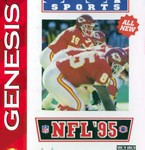
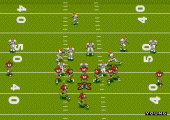
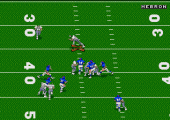
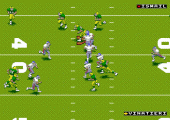
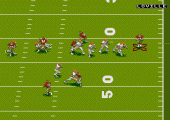
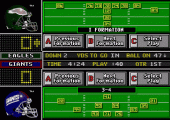
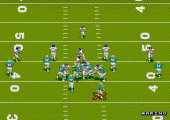
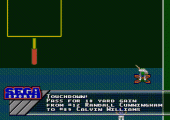
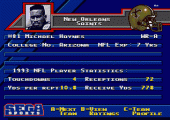
Recent Comments